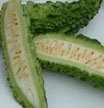Bitter gourd contains vitamin A, B1, B2, and C. It also contains minerals like calcium, phosphorous, iron, copper and potassium. From the ayurvedic perspective, bitter gourd is excellent for balancing Kapha. It helps purify blood tissue, enhances digestion, and stimulates the liver. Young immature bitter gourds are the best for cooking.The skin is bright green in color, the flesh inside is white, and the seeds are small and tender. Mature Karela is not advisable and its better to avoid bitter gourd if you are pregnant or nursing. To prepare bitter gourd for cooking, wash thoroughly, lightly peel the skin, then cut into half lengthwise and scrape out the seeds with a spoon and discard. Cut or slice as called for in your recipe, and blanch for 3-4 minutes in boiling water to which a little salt and turmeric has been added. Drain. I prepare bitter gourd dishes regularly. Today’s bitter gourd recipe is a tangy bitter gourd gravy curry (in Andhra it goes by the name Kakarakaya Pulusu), the recipe of which I will be posting later in the day.
